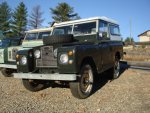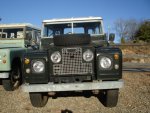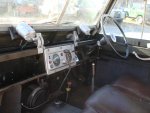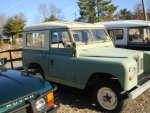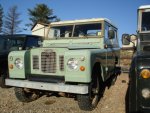I am under no illusion that these are reliable trucks-it's British after all
Series trucks are as reliable as you are willing them to be. They are designed to have regular maintenance performed on them every 3000 miles (For many UK residents that could be once every half year or longer). If you follow the factory recommended maintenance schedule and replace everything that you see that is approaching out of spec instead of making do until catastrophic failure forces you to do some maintenance, they can be quite reliable with a couple exceptions. The exceptions being the 10 spline rear axle that tends to break between 40,000 and 50,000 miles of regular use and more frequently if the truck is used hard and the gearbox which is a little weak for the engine but can last a decade or two without failure or decide to break much earlier.
next, If you are going to become a Series owner you should learn to work on the truck yourself or have deep pockets to pay for that maintenance every 3000 miles. The hard part of the latter is that the factory trained Series mechanics are all retired and it is hard to find a modern mechanic who can even set points correctly.
If you are going to become a Series owner I recommend purchasing the owners manual as it has the recommended factory maintenance schedule and provides step by step instructions for doing the regular maintenance items.
I also recommend getting the white bible, volumes I and II. AKA the factory repair manuals. These take you step by step through the items the factory expected a professional mechanic to do, including rebuilding brakes. If you are not rushed to have the truck moving I suggest the brake project would be a good one to get your feet wet on. umm Literally, we don't want you standing in a puddle of brake fluid that leaked out

Assuming your steel brake lines are good, you should:
- The first thing you want to do is drain and flush the system. Open the bleed screws at each of the wheel cylinders & clutch cylinder and let the fluid drain out. Blow them out with compressed air. Get a gallon of cheap alcohol and pour it through the system. Then blow the system clear again with compressed air.
- Replace the master cylinder. These can be a real pain to rebuild properly and if you are not experienced it can be hard to tell if it is rebuildable.
- Next you want to replace the rubber hoses. The three brake hoses and the clutch hose.
- Before buying wheel cylinder parts you will want to open them up and inspect the bore of each to determine if they are rebuildable. Pull the drums all the way around. If there is oil you will need to replace the inner hub seal. If the brake shoes are worn or oil soaked put them on your shopping list. Make a drawing of where the springs go then remove the shoes. Open up the wheel cylinders and inspect the inside. The cylinder bores were polished inside, not honed so they should wipe clean without pitting or deep scratches. If you can not polish them clean replace them or have them sleeved. If you can polish them clean, rebuild them. A sleeved cylinder will virtually last forever so it is worth doing if you plan to own the truck long term. Go through the same process with the clutch slave cylinder.
- Once you have everything reassembled fill and bleed the system. Since it is a virgin system you need to make the decision of fluid. You can use DOT 5 silicon based brake fluid or DOT 4 brake fluid (Castrol LMA). Which ever you choose you can not switch between the two without first flushing the system and replacing all the rubber including hoses and brake/clutch rubber seals. They can be a real pain to bleed and get all the air out. I strongly prefer pressure bleeding.
If the steel brake lines have rust, replace them. This can be a pain but a rust caused pinhole in a brake line can ruin your whole day very quickly. What you need to know is that the British use a different brake line fitting than the North Americans. They two types will thread into one another but a male US fitting will not set the the flare properly into a UK female fitting and a UK male fitting will set the flare seal with only a couple threads engaged into the North American female fitting.
Make sure UK brake fittings are used at all connections.
My Series Land Rover has taught me more about mechanics than I ever expected or even wanted to know. But it is the price of long term ownership of a Series truck. Especially one you take out into the bush where you need to be able to take care of any problem in order to get it home or out to a place where a tow truck can reach.
Coiler Land Rovers in the US are almost all worn out and crushed before they reach 20 year of age. You youngest North American spec Series truck is 35 years old. Series trucks last because they are easy to work on and simple enough for the average person to learn how to work on them. But they do need the factory maintenance schedule followed if they are going to remain dependable. A series truck is a time and effort commitment that rewards you with more maintenance sessions. You need to become one with the 90 wt and grime if you are to become a long time Series owner.

